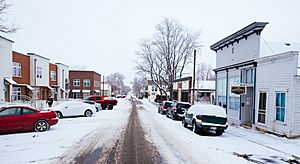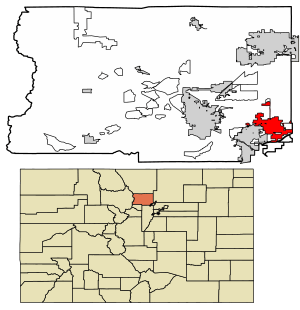Lafayette, Colorado facts for kids
Quick facts for kids
Lafayette, Colorado
|
|
|---|---|
| City of Lafayette | |

Lafayette, Colorado
|
|

Location of the City of Lafayette in Boulder County, Colorado
|
|
| Country | |
| State | |
| County | Boulder County |
| City | Lafayette |
| Founded | 1888 |
| Incorporated | January 6, 1890 |
| Named for | Lafayette Miller |
| Government | |
| • Type | Home Rule Municipality |
| Area | |
| • Total | 24.38 km2 (9.41 sq mi) |
| • Land | 23.86 km2 (9.21 sq mi) |
| • Water | 0.52 km2 (0.20 sq mi) |
| Elevation | 1,605 m (5,266 ft) |
| Population
(2020)
|
|
| • Total | 30,411 |
| • Density | 1,247.37/km2 (3,231.8/sq mi) |
| Time zone | UTC−7 (MST) |
| • Summer (DST) | UTC−6 (MDT) |
| ZIP code |
80026
|
| Area code(s) | Both 303 and 720 |
| FIPS code | 08-41835 |
| GNIS feature ID | 2411592 |
| Highways | US 287, SH 7, SH 42 NW Parkway |
The City of Lafayette is a city in Boulder County, Colorado, United States. It is located in the southeastern part of the county. In 2020, about 30,411 people lived there. Lafayette is known for its history as a coal mining town and its community events.
Contents
Where is Lafayette Located?
Lafayette is in southeastern Boulder County. It shares borders with the town of Erie to the north and east. To the east and south, it borders the city of Broomfield. Louisville is to its southwest.
Main roads in Lafayette include U.S. Highway 287. This highway goes north to Longmont and south to Broomfield and Denver. State Highway 7 goes east from Lafayette to Brighton and west to Boulder.
The city covers about 9.41 square miles (24.38 square kilometers). Most of this area is land, with a small part being water.
Lafayette's Early History
Lafayette was started in 1888 by a woman named Mary Miller. She and her husband, Lafayette Miller, had moved to the area in 1871. They came to farm land they received through the Homestead Act.
After her husband died in 1878, Mary Miller moved back to the farm with her six children. In 1884, coal was found on their land. This discovery led to the start of coal mining in the area. In 1888, Mary Miller set aside 150 acres of her farm. She named this new town Lafayette, after her late husband.
The town of Lafayette was officially formed on January 6, 1890. It quickly became an important part of the coal-mining boom in the region. By 1914, Lafayette was a busy town with banks, hotels, and a brick factory. It even had a power station that supplied electricity to nearby cities.
Mary Miller: A Community Leader
Mary Miller was a very important person in Lafayette's early days. She helped the town rebuild after a big fire in January 1900. In 1892, she started the Miller Bank, which later became the Lafayette Bank.
She was elected president of the bank in 1902. At that time, she was the only woman bank president in the world! Mary Miller was also involved in the temperance movement, which worked to limit alcohol. She even ran for state treasurer. She passed away in 1921.
Coal Mining and Workers' Rights
Lafayette continued to grow as a coal-mining town. Miners often faced tough working conditions. In the 1910s, many miners went on strike to ask for better treatment. There were some difficult times during these strikes. One sad event, known as the Ludlow Massacre, involved conflicts between miners' families and the National Guard.
In 1927, Lafayette's coal miners went on strike again. Another tragic event happened nearby, known as the Columbine Mine Massacre. Five Lafayette miners lost their lives during this conflict.
A woman named Josephine Roche helped the miners. She bought a large part of the Rocky Mountain Fuel Company, which owned many mines. She then made the company much more friendly to its workers. This made life better for the coal miners in Lafayette. Josephine Roche later became a top assistant to the U.S. Secretary of Labor.
Lafayette's Growth and Change
By the 1950s, coal mining became less important as natural gas became popular. The last major coal mine in Lafayette closed in 1956. Lafayette then returned to being mostly a farming community.
As cities like Denver and Boulder grew, more people started moving to Lafayette. This led to more homes being built. The town's economy changed from farming to include more businesses, small industries, and factories.
How People Traveled in Lafayette's Past
Long ago, between 1849 and 1870, gold seekers and stagecoaches traveled through the area. They used the Cherokee Trail, an old trading route. Today, U.S. Highway 287 follows parts of this historic trail.
The Cherokee Trail was a main path for travel to the west. It was part of the Overland Mail and Express Co.'s long route. This company used stagecoaches to deliver mail and carry passengers.
Stagecoach Stops in the Area
The Overland Mail and Express Co. had many stage stations. These were stops where stagecoaches could change horses or passengers could rest. One important crossing was at Boulder Creek, north of Lafayette.
In Lafayette, pioneers Adolf and Anna Waneka ran a stage stop on Coal Creek. This was a place where travelers could get a meal. Mary Miller and her husband also operated the Miller Tavern Ranch, a saloon and stage stop.
Stagecoach travel started to decline after the Transcontinental Railroad was finished in 1867. Trains became a faster way to travel.
Fun Things to Do in Lafayette
Lafayette's most popular spot for fun is Waneka Lake. This is a man-made lake located in Waneka Lake Park.
Waneka Lake Park is a great place for recreation and seeing wildlife. It has playgrounds, picnic areas, and places to fish. There's also a 1.2-mile trail for walking, biking, or running. The park covers 147 acres.
The Historic Waneka Granary
In the southeast part of Waneka Lake Park, you can find Lafayette's oldest building. It's called the Waneka Granary and was built in the 1870s. This old building shows how people built things a long time ago, using hand-cut logs and square iron nails.
Waneka Lake was originally built by Adolf Waneka in 1865. He wanted to store water from a nearby spring. The lake was later expanded and used by a power company. Town founder Mary Miller also owned parts of the lake at different times. The City of Lafayette bought the lake in 1972.
Annual Events in Lafayette
Lafayette hosts many fun events throughout the year. These include a peach festival and a wine festival. There are also "Lafayette Days" celebrations.
Every January, the city holds an oatmeal festival with the Quaker Oats Company. This event includes a fitness run around Waneka Lake. Festival Plaza, in Old Town Lafayette, is a special gathering place for many of these events.
Schools in Lafayette
Public schools in Lafayette are part of the Boulder Valley School District.
- High School: The main public high school is Centaurus High School.
- Middle School: Angevine Middle School is the public middle school.
- Elementary Schools: Lafayette, Alicia Sanchez, Bernard D. 'Pat' Ryan STEAM school, and Pioneer Elementary are the elementary schools. Pioneer Elementary is a bilingual school where students learn in both English and Spanish.
- Charter and Private Schools: Peak to Peak Charter School offers classes from kindergarten through high school. Alexander Dawson School is a private college prep school for K-12 students.
Population of Lafayette
| Historical population | |||
|---|---|---|---|
| Census | Pop. | %± | |
| 1890 | 410 | — | |
| 1900 | 970 | 136.6% | |
| 1910 | 1,892 | 95.1% | |
| 1920 | 1,815 | −4.1% | |
| 1930 | 1,842 | 1.5% | |
| 1940 | 2,052 | 11.4% | |
| 1950 | 2,090 | 1.9% | |
| 1960 | 2,612 | 25.0% | |
| 1970 | 3,498 | 33.9% | |
| 1980 | 8,985 | 156.9% | |
| 1990 | 14,548 | 61.9% | |
| 2000 | 23,197 | 59.5% | |
| 2010 | 24,453 | 5.4% | |
| 2020 | 30,411 | 24.4% | |
| U.S. Decennial Census | |||
In 2010, Lafayette had 24,453 people living in the city. There were 9,632 households. About 36.5% of households had children under 18. The average household had 2.54 people.
The population included people of various backgrounds. About 85.6% were White, 3.8% Asian, and 0.9% Native American. About 18.2% of the population identified as Hispanic or Latino.
The median age in Lafayette was 37.6 years. About 25.4% of the population was under 18 years old.
Places of Worship
Lafayette's first church was the Congregational Church, started in 1890. Mary E. Miller, the town's founder, helped pay for its construction. The Catholic Church of St. Ida was established in 1907, later replaced by Immaculate Conception Catholic Church in 1954. Flatirons Community Church was founded in Lafayette in 1997.
Famous People from Lafayette
Many notable people have connections to Lafayette:
- Bob Beauprez – A Republican politician.
- Devon Beitzel – A former professional basketball player.
- John C. Buechner – An educator, politician, and City Councillor.
- Steven Lindsey – A retired U.S. Air Force officer and NASA astronaut.
- Mary E. Miller – The founder of Lafayette, Colorado.
- Joe Neguse – A U.S. Representative for Colorado.
- Alicia Sanchez – A Latina activist who started Clinica Campesina.
- Jessica Watkins – A geologist, former rugby player, and NASA astronaut.
See also
In Spanish: Lafayette (Colorado) para niños


